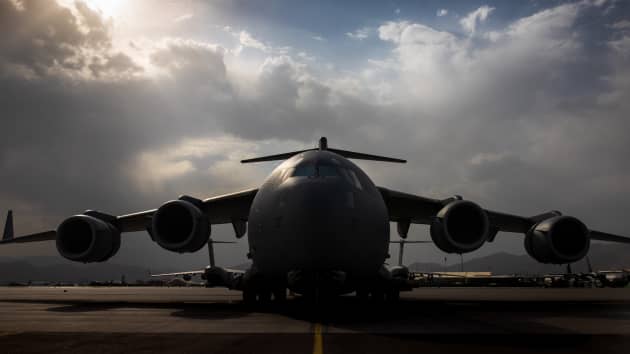
The United States finished its withdrawal efforts from the airport in Kabul, Afghanistan, the Pentagon said Monday, effectively ending a two-decade conflict and war that began not long after the terrorist attacks of Sept. 11, 2001.
After the Pentagon’s announcement, President Joe Biden thanked the American military and said he would address the US about his decision not to prolong the U.S. War in Afghanistan beyond Aug. 31.
“The past 17 days have seen our troops execute the largest airlift in U.S. history, evacuating over 120,000 U.S. citizens, citizens of our allies, and Afghan allies of the United States,” the president said in the statement.
“They have done it with unmatched courage, professionalism, and resolve. Now, our 20-year military presence in Afghanistan has ended.”
In the final week of the withdrawal, terrorists from the group ISIS-K killed 13 U.S. service members and dozens of Afghans in an attack outside the airport.
U.S. forces retaliated and launched strikes in a bid to thwart other attacks.
The last C-17 military cargo aircraft departed Hamid Karzai International Airport on Monday afternoon Eastern time, according to U.S. Marine Corps General Kenneth McKenzie, commander of U.S. Central Command, completing a massive evacuation effort that flew more than 116,000 people out of Afghanistan over the past two weeks.
McKenzie, who oversees U.S. military operations in the region, said the Taliban did not have direct knowledge of the U.S military’s time of departure, adding that commanders on the ground “chose to keep that information very restricted.”

McKenzie said there were no Americans on the last five flights out of Kabul.
“We were not able to bring any Americans out; that activity probably ended about 12 hours before our exit. Although we continue the outreach and would have been prepared to bring them on until the very last minute, none of them made it to the airport,” McKenzie said.
The four-star general added that there were no evacuees left at the airfield when the last C-17 took off and confirmed that all U.S. service members and troops from the Afghan military force along with their families were also airlifted out on Monday.
Secretary of State Antony Blinken said later on Monday that fewer than 200 Americans are still seeking evacuation.
“Our commitment to them and to all Americans in Afghanistan and everywhere in the world continues. The protection and welfare of Americans abroad remain the State Department’s most vital and enduring mission,” the nation’s top diplomat said in an evening address.
As of early Monday, U.S. and allied forces evacuated 1,200 people out of the Afghan capital on 26 military cargo aircraft flights in a 24-hour period, according to the latest figures from the White House.
About 122,800 people have been evacuated since the end of July, including about 6,000 U.S. citizens and their families.
Blinken added that the U.S. had suspended its diplomatic presence in Kabul and will transfer those operations to Doha, Qatar.
“We will remain vigilant in monitoring threats ourselves and will maintain robust counterterrorism capabilities in the region to neutralize those threats if necessary — as we demonstrated in the past few days by striking ISIS facilitators and even threats in Afghanistan, and as we do in places around the world where we do not have military forces on the ground,” Blinken said.
The Taliban return to power
The U.S. began its war in Afghanistan in October 2001, weeks after the attacks of Sept. 11. The Taliban at the time provided sanctuary to al-Qaeda, the group that planned and carried out the devastating terrorist attacks on the World Trade Center and the Pentagon.
Since then, about 2,500 U.S. service members have died in the conflict, which also claimed the lives of more than 100,000 Afghan troops, police personnel, and civilians.
Now the Taliban are yet again in power.
In the final weeks of a planned exodus of foreign forces from Afghanistan, the Taliban carried out a succession of shocking battlefield gains.
The Taliban seized Bagram Air Base, a sprawling and once-stalwart U.S. military installation, less than two months after U.S. commanders transferred it to the Afghan National Security and Defense Force.
In 2012, at its peak, Bagram saw more than 100,000 U.S. troops pass through. It was the largest U.S. military installation in Afghanistan.
As the Taliban moved closer to the capital, Afghan President Ashraf Ghani fled the country, and Western nations rushed to evacuate embassies amid a deteriorating security situation.
Biden ordered the deployment of thousands of U.S. troops to Kabul to help evacuate U.S. Embassy staff and secure the perimeter of the airport.
Despite being vastly outnumbered by the Afghan military, which has long been assisted by U.S. and NATO coalition forces, the Taliban seized the presidential palace in Kabul on Aug. 15.
In April, Biden ordered the full withdrawal of approximately 3,000 U.S. troops from Afghanistan by Sept. 11. He later gave an updated timeline saying the U.S. military mission in Afghanistan will end by Aug. 31.
Following the Taliban takeover, Biden defended his decision that the U.S. would depart the war-torn country.
“I stand squarely behind my decision. After 20 years I’ve learned the hard way that there was never a good time to withdraw U.S. forces,” Biden said a day after Afghanistan collapsed to the Taliban.
Final U.S. casualties of Afghan war
On Sunday, the president and first lady Jill Biden traveled to Dover Air Force Base to meet privately with the families of the fallen before observing the dignified transfer of American flag-draped caskets from a C-17 military cargo plane to a vehicle.
A dignified transfer is a solemn process in which the remains of fallen service members are carried from an aircraft to a waiting vehicle. It is conducted for every U.S. service member killed in action.
The remains of the service members were flown from Kabul to Kuwait and then to Germany before arriving at Dover.





More Stories
Erdogan Warns Israel Against Breaking Ceasefire Promises
Anwar Urges Restoring Trust In Multilateralism, Backs China’s Global Governance Initiative
Malaysia Has Never Wavered In Defending Palestinian Rights- PM Anwar